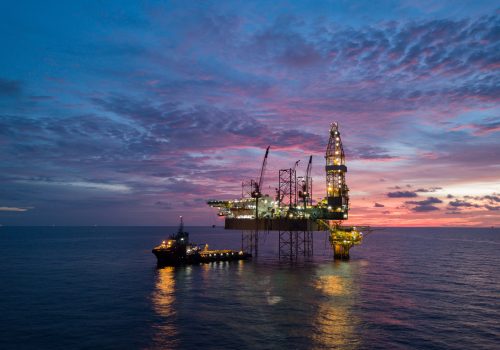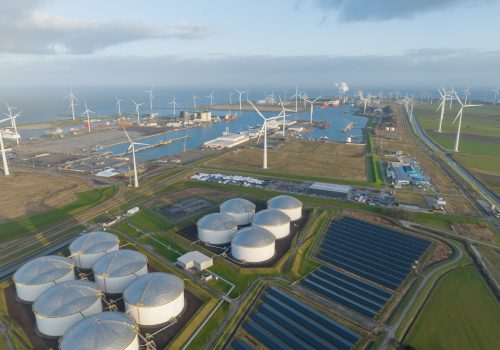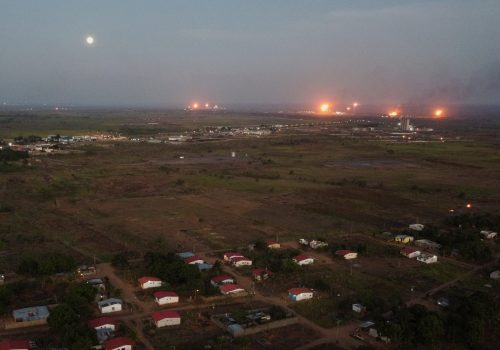Global LNG markets are transforming. It’s an opportunity to enhance energy security.
Winter’s prominence in world natural gas markets is diminishing. Climate change and new energy technologies are moderating Europe’s demand in the winter months for energy and in particular for natural gas. This is good news for Europe’s energy security and a credit to the policies of the European Union (EU) and many national and local governments. But summer gas demand globally is also impacted by rising summer temperatures. Taken together, the impacts of these two trends on global liquefied natural gas (LNG) markets and prices could be consequential.
Climate change is generally raising winter temperatures in Europe, reducing seasonal heating and power needs. The deployment of energy efficiency improvements, two-way air conditioning units (commonly referred to as heat pumps), and renewables, such as offshore and onshore wind, are further decreasing European natural gas demand for winter heating and the power sector. While energy efficiency and heat pumps will pressure natural gas demand throughout the year, the EU’s buildout of winter-peaking wind capacity will have significant seasonal implications. Europe’s “flatter” winter peak demand will enhance European energy security by leaving it with more leverage vis-à-vis Moscow, which continues to pump and export billions of cubic meters of gas to the continent each year.
“Flatter” interseasonal variation in demand could impact more than just Europe: Other systemic implications for global LNG are likely. With both winter and summer temperatures generally rising across the Northern Hemisphere due to climate change, it is likely that winter LNG demand will decrease even as summer consumption needs rise, leading to less global interseasonal variations in peak demand. Furthermore, the “equatorialization” of LNG demand—that is, greater consumption of LNG in markets closer to the equator—will amplify cooling needs and summer periods of peak demand. This can have important implications for energy storage policies and aggregate demand. While further research and rigorous modeling of these trends are required before the extent of these shifts are known, countries around the world appear set to shift how they consume LNG.
Climate change is reducing winter gas demand
Natural gas demand peaks in the Northern Hemisphere in winter due to the distribution of the world’s population and the energy requirements needed to achieve comfortable temperatures. As temperatures decline across the Northern Hemisphere, end users burn more natural gas for heating, industrial use, and power than they do in other seasons. About 90 percent of the world’s population is located in the Northern Hemisphere, along with most of the world’s largest LNG importers in Europe and Asia. Due to these two factors, European—and world—natural gas consumption peaks in winter.
Heating degree days and cooling degree days are proxies used to measure energy needs by comparing the mean daily temperature from 65 degrees Fahrenheit. The Northern Hemisphere’s temperatures tend to show greatest variance from 65 degrees Fahrenheit during winter, especially in northern climates, such as Europe.
Peak winter natural gas demand in northern climes is already impacted by climate change and warmer temperatures. In the EU, the number of heating degree days fell by 19 percent from 1979 to 2022 (Japan saw a 14.5 percent decline in heating degree days from 2000 to 2020). In 2022, heating degree days were 12 percent below their prior-year levels, reducing residential and commercial natural gas demand by around 18 billion cubic meters (bcm), according to the International Energy Agency (IEA). Holding all else constant, rising temperatures have reduced Europe’s winter gas needs and will continue to do so.
Reducing demand
Europe’s winter natural gas demand will also increasingly be moderated by energy efficiency, heat pumps, and the adoption of renewables, especially wind. Building modernization and heat pumps will reduce natural gas heating demand, while renewables will reduce the amount of natural gas burned to generate power.
Electricity-driven heat pumps, which typically provide both heating and cooling needs, are already impacting natural gas consumption in Europe. A record three million heat pumps were sold in the EU in 2022, and one energy industry analyst offers a back-of-the-envelope estimate that every million heat pumps reduces natural gas demand by around 1 bcm per year (with substantial variation due to housing stock). Looking ahead, the IEA projects that heat pumps will account for 21 bcm by 2030 in demand reduction in its aggressive Announced Pledges Scenario, although it’s worth mentioning that heat pumps have faced political blowback in Germany and elsewhere due to concerns over costs, shortfalls of equipment and personnel, and budgetary mechanisms.
Energy efficiency, especially in buildings, may be an even more important factor than heat pumps in dampening Europe’s overall natural gas demand. The IEA’s Announced Pledges Scenario in November 2022 projected that the EU’s annual consumption of gas for heating in buildings would fall by about 42 bcm by 2030 due to factors other than heat pumps, with energy efficiency retrofits comprising the majority of the decline.
Europe has backed energy efficiency talk with serious investment, as the EU’s Renovation Wave aims to decarbonize thirty-five million buildings by 2030, at a total cost of 2.75 trillion euros. The data show why this level of investment may be appealing to policymakers: Buildings account for 40 percent of the EU’s final energy consumption, along with 36 percent of energy-related greenhouse gas emissions. Moreover, improving the energy efficiency of the worst-performing buildings can deliver massive benefits: electricity consumption in Danish homes is up to thirty times lower in homes with the highest efficiency rating compared with the lowest efficiency rating, according to the IEA.
Europe has also taken steps to decarbonize new buildings. As part of its Fit for 55 package, the EU reached a provisional political agreement in December 2023 over the energy performance of new buildings. The agreement states that the minimum energy performance standards by 2030 in all nonresidential buildings will be above the 16 percent worst-performing and by 2033 will be above the 26 percent worst-performing. While the agreement is not finalized, there is substantial evidence that the Europeans will continue to vigorously pursue energy efficiency measures, including via creative public-private partnerships.
Displacing demand
Gas used in the power sector accounts for about 30 percent of Europe’s gas demand. While energy efficiency retrofits and heat pumps will reduce overall natural gas demand throughout the year, renewables generation will lower Europe’s peak winter demand for natural gas, especially for power generation, all else being equal. Onshore and offshore wind in particular could weaken demand for natural gas in winter, since winter months, when winds are often strongest, tend to produce more wind power.
Displacement of natural gas in the winter power mix will largely depend on the speed of offshore and onshore wind deployment, as well as nuclear energy generation. The EU aims to increase installed wind capacity to 500 gigawatts (GW) in 2030, up from 204 GW in 2022, although the global and European wind industry has faced challenges due to cost inflation spurred by supply chain issues and high interest rates.
Even if the EU is unable to meet its ambitious wind objectives, however, wind is already competing with natural gas during the winter. Indeed, wind’s share of all EU electricity generation from winter generation rose from 12 percent in the winter of 2015/2016 to 19 percent in the winter of 2022/2023, per our analysis of data from the think tank Ember. If wind’s share of winter power output rises from 2022/2023 levels to 26 percent by 2030—a modest goal, given that the EU seeks to more than double wind capacity by 2030—coal and natural gas will be impacted.
So far, winter demand for coal and nuclear energy—not natural gas—has primarily been displaced by the rise of European renewables. Coal, the most polluting hydrocarbon, is clearly on the way out due to policy measures and challenging economics. European nuclear energy generation has fallen to lows last seen in the mid-1980s and appears unlikely to rebound from its current lows until the 2030s at the earliest. Going forward, winter-peaking wind generation and, to a lesser degree, solar and batteries, will begin to compete with natural gas more vigorously in Europe’s winter electricity mix.
By 2030, the combination of higher temperatures, building modernization, heat pumps, and renewables generation could reduce Europe’s winter natural gas demand by dozens of bcm, all things being equal.
Implications for LNG markets and European energy security
What does this mean for global LNG demand? While the implications of reduced winter LNG demand in Europe over time remain uncertain, some potential outcomes are worth exploring. For example, if high-income Asian countries and equatorial buyers invest in storage for energy security reasons, then there could be a deeper and more flexible global LNG market, with more consumers able to manage supply disruptions and trade cargoes (as seen in the wake of Russia’s invasion of Ukraine). But geologic storage is costly and unavailable in many markets, and undesirable to construct in countries that see gas as a transition fuel.
It is therefore much more likely that there will be a significant increase in the demand for LNG transportation and storage infrastructure. Orders for new LNG tankers amount to half the number of tankers that currently exist. There should be a significant increase in demand for LNG tankers, both for shipping and as storage devices, as well as an increase in demand for floating storage and regasification units as countries opt for more flexible forms of gas storage (such as Floating Storage Regasification Units, or FSRUs). The impact of this change in demand on price will significantly depend on the adequacy of supply, including whether the United States sustains its role as a major incremental supplier of competitively priced fuel, and whether the manufacturers of LNG tankers and FSRUs can keep up with global demand.
Of course, the emergence of new LNG demand centers close to the equator will also raise summer demand for cooling needs. India, Pakistan, Bangladesh, and other equatorial markets are all examining LNG due to its usefulness as a baseload fuel source and its benefits for urban air quality. As these equatorial economies turn to LNG, world gas demand will increasingly shift from winter to summer.
Equatorial cooling needs will be significant. In 2019, India alone experienced more than 3,600 population-weighted cooling degree days (PWCDD), a measure of cooling needs. Further north, Spain and the United States required only 629 and 865 PWCDD, respectively, in the same year. Notably, hotter countries can see a rise in electricity demand of more than 50 percent in the summer. Additionally, demand within the northerly economies will also shift, as the number of cooling degree days in the EU nearly quadrupled from 1979 to 2022. Climate change and the equatorialization of global demand will lead to less winter heating needs and more cooling requirements.
Changing LNG markets are an opportunity
LNG markets are shifting gradually but perceptibly. More rigorous work needs to be done to model the shifting regional and temporal demand profile of global natural gas, rising global temperatures, and the equatorialization of natural gas. More research is needed, for example, to confirm if these changes will lead to more consistent, year-round consumption. With better information about these trend lines, manufacturers of tankers and FSRUs (as well as LNG suppliers) will have more accurate demand signals and policymakers can explore the opportunity for storage and trading policy to create less volatility in LNG markets. In addition, the impacts of these interseasonal variations on aggregate LNG demand must be modeled so that changes in European gas demand are not reflexively interpreted as the harbinger of reduced aggregate LNG demand.
The world is entering a new era for European and, potentially, global LNG markets. There is a great opportunity here for enhanced energy security—and climate security—not just in the Northern Hemisphere, but worldwide, especially if natural gas value chain emissions are mitigated. But this opportunity should not be missed.
David Goldwyn is president of Goldwyn Global Strategies, LLC, chairman of the Atlantic Council Global Energy Center’s Energy Advisory Group, and the former special envoy and coordinator for international energy affairs at the US State Department.
Joseph Webster is a senior fellow at the Atlantic Council and editor of the China-Russia Report.
The authors are grateful to Andrea Clabough, senior associate at Goldwyn Global Strategies, LLC, and nonresident fellow at the Global Energy Center for her contributions to this article.
This article reflects their own personal opinions.
Further reading
Tue, Dec 5, 2023
The Oil and Gas Decarbonization Charter is a start, but more work remains
EnergySource By David L. Goldwyn, Andrea Clabough
Although the Oil and Gas Decarbonization Charter is laudable, the pace of change for this industry (as represented in this charter) is not fast enough, deep enough, or broad enough to materially address the yawning gap between the Paris commitments and the present Dubai reality.
Thu, Nov 30, 2023
The 2024 Global Energy Agenda
Global Energy Agenda By
The fourth edition of the Global Energy Agenda kicks off with a collection of essays by energy leaders that are rolling out during COP28. Rounding out the Agenda in early 2024, the Atlantic Council Global Energy Center will release the results of its annual survey of experts that takes the pulse on the geopolitical risks affecting energy markets, the future of fossil fuels, and the transition to clean energy.
Tue, Oct 24, 2023
Why COP28 is right to prioritize global methane and flaring reduction
Issue Brief By
Flaring and methane emissions from oil and gas are a substantial source of greenhouse gas emissions globally, but the funding, technology, and business practices are available to bring these emissions to near-zero. The COP28 platform can accelerate these solutions.
Image: The LNG terminal vessel Transgas Force is moored in Kaiserhafen Drei at the Lloyd shipyard in Bremerhaven. Built in 2021, the approximately 300-meter-long vessel is a floating storage and regasification unit (FSRU) and is scheduled to be deployed at the LNG terminal in Stade from the end of 2023. Prior to this, adaptation work will be carried out by the Lloyd shipyard.


